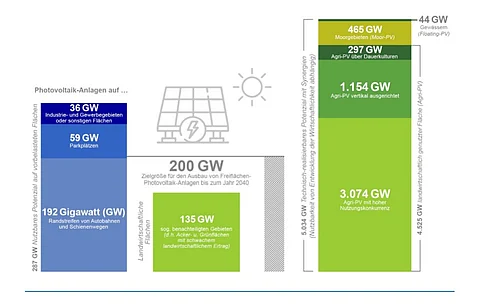

Space shouldn't be a problem for Germany to meet its open space solar PV targets as the country can accommodate 287 GW solar PV capacity using verges along motorways and railways, above parking lots, and on commercial and industrial (C&I) properties.
Oeko-Institut, which offers this estimate in a study, says this 287 GW can be distributed between 192 GW along highways and railways, 59 GW in parking lots and 36 GW on industrial and commercial properties.
Under its Renewable Energy Sources Act (EEG), Germany aims to expand its cumulative installed solar PV capacity from 81.9 GW at the end of 2023 to 215 GW by 2030 and 400 GW by 2040 (see Germany's Bundestag Clears Easter Package).
Of the 400 GW, 200 GW is targeted to be installed as ground-mounted PV. If the above-mentioned spaces are exploited, the analysts believe only a small amount of agricultural land with lower yields will be used for solar PV systems.
Nonetheless, expanding the coverage to other possible areas like moors, water bodies and other crop-yielding agricultural areas expands the country's technical solar PV potential to exceed 5 TW.
The institute has also touched upon the challenges faced by open-space solar systems. It recommends citizen participation in profits from such systems as one way to increase acceptance and help shape the energy transition.
In yet another study, focused on agrivoltaics in Germany, the institute reflects on all possible available agricultural space for to help the country expand solar PV capacity.
The highest potential for dual use of land for PV and agricultural use, according to the authors, is presented by arable land, grassland and permanent crops.
It estimates more than 13 million hectares of land as offering the geographical potential to be used for agrivoltaic projects, representing 37% of the national land area. Referring to various independent research sources, the institute says PV shading can benefit crops like potatoes and spinach, thus improving yield.
Additionally, research has shown that conventional south-facing agrivoltaic installations may not always work for some crops and plants as these lead to persistent shading. Hence, in such cases, solar systems can be oriented in either the southeast or southwest direction.
The report writers have identified around 4.3 million hectares of land with developable potential for agrivoltaics. Of this, around 400,000 hectares can be used with permanent crops, while 3.9 million hectares are of medium and poor soil quality, which means this is suitable for PV deployment.
Both the reports—Photovoltaik-Freiflächenanlagen in Deutschland, and Potenzialflächen für AgriPhotovoltaik—are available on Oeko-Institut's website, in German.
A September 2022 study by the University of Hohenheim and Thünen Institute also explored agrivoltaics' potential in Germany and claimed that solar panels on 1% of arable land in the country can cover around 9% of the electricity demand here (see Study Explores Agrivoltaics As Positive For Germany).
